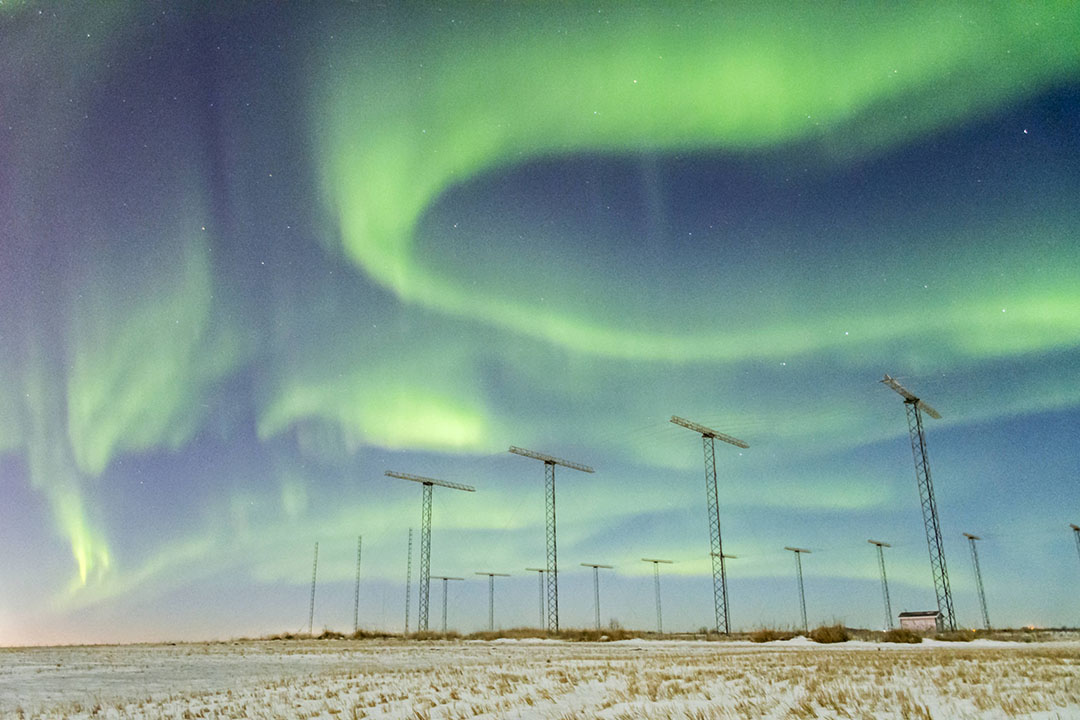
Four things to know about SuperDARN at USask
Located at the University of Saskatchewan (USask), the Canadian component of the Super Dual Auroral Radar Network (SuperDARN) is monitoring space weather and studying its impacts on Earth.
By Erin Matthews, Research Profile and ImpactWay up in the sky and invisible to the human eye lives a layer of charged particles that hold key information about powerful space storms. While captivating and beautiful in the form of northern lights, these space weather events can also wreak havoc on our communications systems. In 1989, a severe magnetic storm knocked out the Hydro-Quebec transmission system and plunged the province into darkness for nine hours.
With more than 35 radars interspersed across the world, SuperDARN keeps tabs on these space weather events by monitoring changes in the charged particles that create the upper layer of the earth’s atmosphere known as the ionosphere.
SuperDARN’s radars bounce a signal off the ionosphere, looking for irregularities that help predict weather in space and any potential solar storms that could interfere with our power grids or knock out the internet.
Saskatoon has been home base for SuperDARN Canada for three decades
SuperDARN Canada has been operating in Saskatoon since 1993 and is based in the Institute of Space and Atmospheric Studies in the Department of Physics and Engineering Physics at USask.
As one of the founding partners of SuperDARN, Canada’s location is ideal for studying the interaction between the sun and the Earth and gather information from the auroral oval, a region where the northern lights are the most active.
In total, SuperDARN Canada uses five radars to gather data about near-Earth space and keep tabs on activity in the sky above. These radars are operated in Saskatchewan, British Columbia, the Northwest Territories, and Nunavut. Two of the most remote radar sites are in Rankin Inlet and Clyde River, both located in Nunavut.
SuperDARN is funded by the Canadian Foundation for Innovation (CFI)
SuperDARN Canada has received support from CFI for 10 years and is one of four USask facilities that are funded by the Canada Foundation for Innovation Major Science Initiative Fund (CFI-MSI). CFI-MSI supports 19 facilities across Canada that drive innovative research, including USask’s Vaccine and Infections Disease Organization (VIDO), Canadian Light Source (CLS), Global Water Futures Observatory (GFWO) and, of course, SuperDARN Canada.
The director of SuperDARN Canada is an award-winning, trailblazing scientist
Dr. Kathryn McWilliams (PhD), director of SuperDARN Canada, has been with the project since the beginning. As an undergraduate student, McWilliams helped build the Saskatoon radar site. Earning both her bachelor’s and master’s degrees at USask, McWilliams returned after her PhD to become the first tenured female faculty member in the physics department.
In 2019, McWilliams was the first Canadian to be appointed chair of the international SuperDARN executive council. In 2022, she was awarded an honorary fellowship from the Royal Astronomical Society (RAS) of the United Kingdom.
McWilliams was recently featured in Canadians Who Innovate: The Trailblazers and Ideas That Are Changing the World, a book published in 2024.
SuperDARN Canada welcomed international intern to help optimize antennas
The USask team welcomes interns to work on projects related to SuperDARN’s activities. This summer, SuperDARN Canada collaborated with the European aerospace company AIRBUS France and their apprentice Guilhem Pujo for an international internship — a first for the USask group.
As an engineering student and AIRBUS apprentice, Pujo worked on finetuning flight computer systems to improve how an aircraft performs. Pujo used his expertise in refining equipment to improve the signal of SuperDARN’s radar by designing a new balun, an electrical device, for the radar’s transmitter. During his internship at SuperDARN, Pujo computer-tested his design and demonstrated that it could improve the performance of the radar by 10 per cent.
The important work of SuperDARN Canada continues as the end of 2024 ushers in more powerful and more frequent solar events. Every 11 years the activity of the sun reaches a peak, known as the solar maximum, bringing more geostorms, volatility to space weather and beautiful northern lights. With the solar maximum in full swing, SuperDARN’s radars will be working overtime, gathering important data to help us understand the infinite worlds above our heads.
Together, we will undertake the research the world needs. We invite you to join by supporting critical research at USask.

